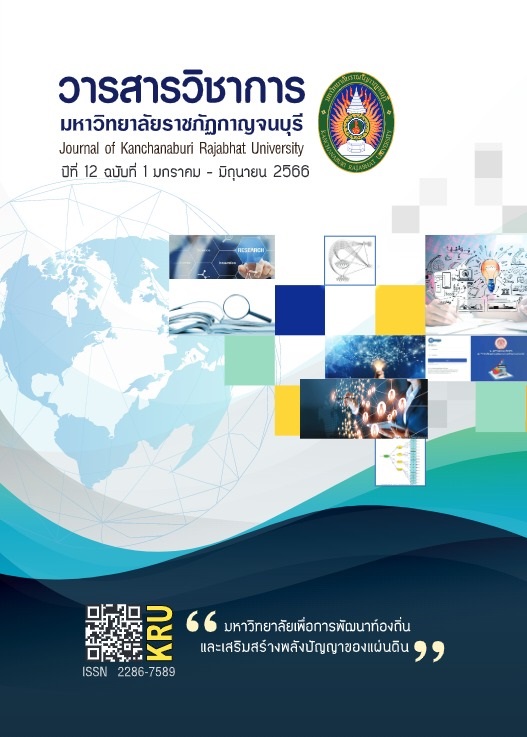A COMPONENTS ANALYSIS OF THAI YOUTH CHARACTERISTICS IN DISRUPTIVE INNOVATION ERA การวิเคราะห์องค์ประกอบคุณลักษณะของเยาวชนไทยในยุค Disruptive Innovation
Main Article Content
Abstract
The objectives of this research were: 1) to components analysis of Thai youth characteristics in disruptive Innovation era 2) to examine the conformity of components model of Thai youth characteristics in disruptive innovation era. This research was the mix methodology research. The data collection was imposed upon the two forms of research, qualitative and quantitative. The qualitative research has been employed by the open-ended questions for interviewing, for instant, information technology academics, assessment measurement academics information and technology entrepreneurs. On the one hand, the quantitative research manifested in the questionnaires designed for 540 Thai youths in the area of Suphan Buri province, aged between 18-25 years, using stratified random sampling. The statistics for data analysis were exploratory factor analysis by using LISREL program. The findings of the study were as follows: 1) The components analysis of Thai youth characteristics in disruptive Innovation era were composed of 4 factors as following: component of creativity and innovation are weight values between 0.80-0.86, component of information, media and technology are weight values between 0.79-0.88, component of life and career are weight values between 0.82-0.86, component of social and ethical are weight values between 0.81-0.84. 2) The construct validity of structural model which analyzed by the exploratory factor analysis showed by the Chi-Square Goodness of Fit Index is 924.44, degree of freedom (df) is 100, probability (p – value) is 0.00, Comparative of Fit Index (CFI) is 0.96, Adjusted Goodness of Fit Index (AGFI) is 0.76 and Root Mean Square Residual (RMR) is 0.051.
Article Details

This work is licensed under a Creative Commons Attribution-NonCommercial-NoDerivatives 4.0 International License.
References
กัญณภัทร หุ่นสุวรรณ, บุญเรือง ศรีเหรัญ และชาตรี เกิดธรรม และคณะ. (2557). การศึกษาองค์ประกอบคุณลักษณะ
ของนักเรียนระดับชั้นประถมศึกษา เพื่อการเข้าสู่ประชาคมอาเซียน. วารสารราชภัฏเพชรบูรณ์สาร, 16(1), 45-55.
โกศล แตงอุทัย. (2559). อภิวัฒน์การเรียนรู้สู่จุดเปลี่ยนประเทศไทย. ค้นเมื่อ ธันวาคม 22, 2562,
จาก http://www.youtube.com/watch?v=e51MVmTJz-U.
จาตุรนต์ ฉายแสง. (2556). นโยบายด้านการศึกษารัฐมนตรีว่าการกระทรวงศึกษาธิการในวันพฤหัสบดีที่ 11
กรกฎาคม 2556 ณ ห้องประชุมราชวัลลภ กระทรวงศึกษาธิการ. ค้นเมื่อ มกราคม 15, 2563,
จาก https://silo.tips/download/11-2556.
ทนุภา สายทิพย์. (2558). การศึกษาสภาพปัจจุบันปัญหาและแนวทางการพัฒนาการบริหารงานวิชาการโรงเรียน
สังกัด เทศบาลนครขอนแก่น. วารสารวิทยาลัยบัณฑิตเอเซีย, 5(1), 56-58.
ธันยวิช วิเชียรพันธ์ และปวีณา จันทร์สุข. (2556). รายงานโครงการพัฒนาเครื่องมือเพื่อเสริมสร้างทักษะ
แห่งศตวรรษที่ 21 ของเด็กและเยาวชนไทย เพื่อเตรียมความพร้อมสู่ประชาคมอาเซียน. กรุงเทพฯ:
สำนักงานส่งเสริมสังคมแห่งการเรียนรู้และคุณภาพเยาวชน (สสค.).
เบญจวรรณ ถนอมชยธวัช, ผ่องศรี วาณิชย์ศุภวงศ์, วุฒิชัย เนียมเทศ และณัฐวิทย์ พจนตันติ. (2559). ทักษะแห่งศตวรรษที่ 21:
ความท้าทายในการพัฒนานักศึกษา. วารสารเครือข่ายวิทยาลัยพยาบาลและการสาธารณสุขภาคใต้, 3(2), 208-222.
ปิยะบุตร ชลวิจารย์. (2559). อภิวัฒน์การเรียนรู้สู่จุดเปลี่ยนประเทศไทย. ค้นเมื่อ มกราคม 15, 2563,
จาก http://www.youtube.com/watch?v=e51MVmTJz-U.
พระอำนาจ อตถกาโม (น้อยนิล). (2554). การศึกษาคุณลักษณะอันพึงประสงค์ของนักเรียนโรงเรียนศึกษา
สงเคราะห์บางกรวย อำเภอบางกรวย จังหวัดนนทบุรี. วิทยานิพนธ์ปริญญาพุทศาสตรมหาบัณฑิต
สาขาวิชาการบริหารการศึกษา บันฑิตวิทยาลัย มหาวิทยาลัยจุฬาลงกรณ์ราชวิทยาลัย.
พาที เกศธนากร. (2561). การพัฒนาตัวบ่งชี้ทักษะของนักศึกษาในศตวรรษที่21คณะครุศาสตร์มหาวิทยาลัยราชภัฏ
กาญจนบุรี. วารสารราชภัฏเพชรบูรณ์สาร, 20(1), 97-107.
วิชัย วงษ์ใหญ่ และมารุต พัฒผล. (2562). การจัดการเรียนรู้ในยุค Disruptive Innovation. กรุงเทพฯ: ศูนย์ผู้นำนวัตกรรมหลักสูตรและการเรียนรู้.
วิจารณ์ พานิช. (2558). วิถีสร้างการเรียนรู้เพื่อศิษย์ ในศตวรรษที่ 21. วารสารนวัตกรรมการเรียนรู้, 1(2), 3-14.
สำนักงานคณะกรรมการพัฒนาการเศรษฐกิจและสังคมแห่งชาติ สำนักนายกรัฐมนตรี. (2560). แผนพัฒนาเศรษฐกิจ และสังคมแห่งชาติ ฉบับที่ 12. ค้นเมื่อ
มกราคม 15, 2563, จาก https://www.nesdc.go.th/ewt_dl_link.php?.
สำนักงานคณะกรรมการการอุดมศึกษา. (2550). กรอบแผนอุดมศึกษาระยะยาว 15 ปี ฉบับที่ 2 ปี พ.ศ.2551-
สำนักงานคณะกรรมการการอุดมศึกษา กระทรวงศึกษาธิการ กรุงเทพฯ: จุฬาลงกรณ์มหาวิทยาลัย.
สำนักบริหารทะเบียน กรมการปกครองกระทรวงมหาดไทย. (2562). สถิตประชากรทางทะเบียนราษฏร.
ค้นเมื่อ มกราคม 15, 2563, จาก https://stat.bora.dopa.go.th/stat/statnew/statMONTH/ statmonth/#/mainpage.
Cronbach, Lee Joseph. (1974). Essentials of Psychological Testing. 3rd Ed. New York: Harper and Row.
Gustavo Carlo & Branddy Randall. (2002). The Development of a Measure of Prosocial
Behaviors for Late Adolescents. Journal of Youth and Adolescence, 31(1), 31-44.
Hair, J.F. and others. (2006). Multivariate data analysis. 6th ed. Upper Saddle River, N.J.: Pearson Education Inc.


